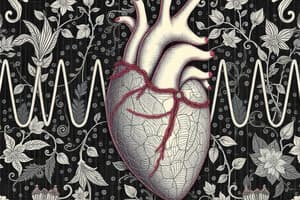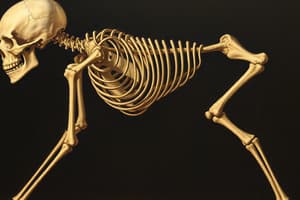Podcast
Questions and Answers
What are the three common types of paroxysmal SVT?
What are the three common types of paroxysmal SVT?
- Atrioventricular nodal reentrant tachycardia, atrioventricular reentrant tachycardia, atrial tachycardia (correct)
- Atrial fibrillation, atrial flutter, ventricular tachycardia
- Sinus tachycardia, atrial tachycardia, atrioventricular nodal tachycardia
- Wolff-Parkinson-White syndrome, atrial fibrillation, atrial flutter
What may be included in the diagnostic evaluation of paroxysmal SVT?
What may be included in the diagnostic evaluation of paroxysmal SVT?
- MRI and CT scan
- X-ray imaging and ultrasound
- Blood pressure monitoring and lung function tests
- Comprehensive history and physical examination, electrocardiography, and laboratory workup (correct)
In which setting is the acute management of paroxysmal SVT best completed?
In which setting is the acute management of paroxysmal SVT best completed?
- Outpatient setting
- Urgent care clinic
- Emergency department or hospital setting (correct)
- Primary care physician's office
What is the first-line management for patients who are hemodynamically unstable with paroxysmal SVT?
What is the first-line management for patients who are hemodynamically unstable with paroxysmal SVT?
Which of the following symptoms may be associated with paroxysmal SVT?
Which of the following symptoms may be associated with paroxysmal SVT?
Which of the following is the most common type of paroxysmal SVT?
Which of the following is the most common type of paroxysmal SVT?
What is the first-line management for paroxysmal SVT in those who are hemodynamically stable?
What is the first-line management for paroxysmal SVT in those who are hemodynamically stable?
What is a common trigger for AVNRT, especially in young people?
What is a common trigger for AVNRT, especially in young people?
What is a highly successful method for long-term management of recurrent, symptomatic paroxysmal SVT?
What is a highly successful method for long-term management of recurrent, symptomatic paroxysmal SVT?
What is the prevalence of paroxysmal SVT in the general population?
What is the prevalence of paroxysmal SVT in the general population?
Which cardiac comorbidity can trigger reentrant tachycardias, especially in older patients?
Which cardiac comorbidity can trigger reentrant tachycardias, especially in older patients?
Which type of Supraventricular Tachycardia (SVT) is the second most common overall and the most common in children?
Which type of Supraventricular Tachycardia (SVT) is the second most common overall and the most common in children?
What is the characteristic ECG feature in AVRT that can result in hidden P waves?
What is the characteristic ECG feature in AVRT that can result in hidden P waves?
What causes anterograde preexcitation identified by a short PR interval, a slurred QRS complex upstroke (delta wave), and a wide QRS complex?
What causes anterograde preexcitation identified by a short PR interval, a slurred QRS complex upstroke (delta wave), and a wide QRS complex?
Which type of Supraventricular Tachycardia (SVT) is less common than AVRT, accounting for about 10% of all SVT cases, and is often found in young adults?
Which type of Supraventricular Tachycardia (SVT) is less common than AVRT, accounting for about 10% of all SVT cases, and is often found in young adults?
What condition results from an accessory pathway that conducts anterogradely, causing a delta wave and increasing the risk of arrhythmias such as atrial fibrillation and sudden cardiac death?
What condition results from an accessory pathway that conducts anterogradely, causing a delta wave and increasing the risk of arrhythmias such as atrial fibrillation and sudden cardiac death?
In which type of Supraventricular Tachycardia (SVT) do PR intervals typically remain normal due to unchanged delay from the atrioventricular node?
In which type of Supraventricular Tachycardia (SVT) do PR intervals typically remain normal due to unchanged delay from the atrioventricular node?
Which type of tachycardia can manifest with a retrograde accessory pathway and antidromic conduction, and does not require Wolff-Parkinson-White syndrome?
Which type of tachycardia can manifest with a retrograde accessory pathway and antidromic conduction, and does not require Wolff-Parkinson-White syndrome?
What type of atrial tachycardia typically presents as a regular atrial rhythm with a 1:1 ratio of atrioventricular conduction and may involve a 'warm up' phenomenon?
What type of atrial tachycardia typically presents as a regular atrial rhythm with a 1:1 ratio of atrioventricular conduction and may involve a 'warm up' phenomenon?
Which type of atrial tachycardia may have a sudden onset and repetitive short bursts, due to increased automaticity?
Which type of atrial tachycardia may have a sudden onset and repetitive short bursts, due to increased automaticity?
What is an important consideration in the diagnostic evaluation of SVT in relation to postural changes?
What is an important consideration in the diagnostic evaluation of SVT in relation to postural changes?
What type of evaluation for SVT may involve assessing vital signs, performing focused physical examination, and inducing tachycardia to determine the underlying cause?
What type of evaluation for SVT may involve assessing vital signs, performing focused physical examination, and inducing tachycardia to determine the underlying cause?
What is an important part of the differential diagnosis of SVT?
What is an important part of the differential diagnosis of SVT?
What is the first-line acute management approach for narrow complex paroxysmal supraventricular tachycardia (SVT)?
What is the first-line acute management approach for narrow complex paroxysmal supraventricular tachycardia (SVT)?
Which medication is used in hemodynamically stable patients for terminating narrow complex SVT or as a diagnostic and therapeutic agent in wide complex tachycardia?
Which medication is used in hemodynamically stable patients for terminating narrow complex SVT or as a diagnostic and therapeutic agent in wide complex tachycardia?
What is a part of the short-term medication management for paroxysmal SVT?
What is a part of the short-term medication management for paroxysmal SVT?
Which diagnostic testing is commonly included for patients with paroxysmal SVT?
Which diagnostic testing is commonly included for patients with paroxysmal SVT?
What is the initial acute management approach for wide complex tachycardia?
What is the initial acute management approach for wide complex tachycardia?
What is a part of the long-term management for paroxysmal SVT?
What is a part of the long-term management for paroxysmal SVT?
Which medication is a short-term treatment for paroxysmal SVT and has an indication as a sodium channel blocker?
Which medication is a short-term treatment for paroxysmal SVT and has an indication as a sodium channel blocker?
What is the class indication for verapamil in the treatment of SVT?
What is the class indication for verapamil in the treatment of SVT?
Which medication should be avoided in patients with a prolonged QT interval due to its adverse effects?
Which medication should be avoided in patients with a prolonged QT interval due to its adverse effects?
In case of wide complex tachycardia, what should it be treated as until proven otherwise?
In case of wide complex tachycardia, what should it be treated as until proven otherwise?
Which medication is a long-term treatment used to decrease heart rate with a class IIa indication and should not be used in patients having preexcitation or with a wide QRS complex?
Which medication is a long-term treatment used to decrease heart rate with a class IIa indication and should not be used in patients having preexcitation or with a wide QRS complex?
Which medication is a long-term treatment used to prevent SVT with a class IC indication and should not be used in patients with structural or ischemic heart disease, wide QRS complex, or atrioventricular blocks?
Which medication is a long-term treatment used to prevent SVT with a class IC indication and should not be used in patients with structural or ischemic heart disease, wide QRS complex, or atrioventricular blocks?
What can be used as a first-line treatment for wide complex tachycardia in hemodynamically stable hospitalized patients?
What can be used as a first-line treatment for wide complex tachycardia in hemodynamically stable hospitalized patients?
What are the indications for cardiology referral when evaluating a patient with known or suspected paroxysmal SVT in the outpatient setting?
What are the indications for cardiology referral when evaluating a patient with known or suspected paroxysmal SVT in the outpatient setting?
What can be used to distinguish between paroxysmal SVT with aberrant conduction and ventricular tachycardia?
What can be used to distinguish between paroxysmal SVT with aberrant conduction and ventricular tachycardia?
What is the main adverse effect of diltiazem in the context of SVT treatment?
What is the main adverse effect of diltiazem in the context of SVT treatment?
Study Notes
- Supraventricular tachycardia (SVT) is a type of heart rhythm disorder, and there are different medication management options for its treatment.
- Ibutilide is a short-term medication used to treat paroxysmal SVT in adults with a class IIIa indication. It is a potassium channel blocker that prolongs repolarization, and it has adverse effects such as proarrhythmic effects and should be avoided in patients with a prolonged QT interval.
- Diltiazem and verapamil are long-term medications used to prevent SVT, with a class IVa indication. Diltiazem is a calcium channel blocker that can cause bradycardia and conduction disturbance. Verapamil is also a calcium channel blocker that can cause hypotension and bradycardia. Both have adverse effects and should be used with caution in patients with heart failure.
- Flecainide is a short-term medication used to treat paroxysmal SVT with a class IC indication. It is a sodium channel blocker that slows conduction and has adverse effects such as proarrhythmic effects, conduction disturbance, dizziness, and visual disturbance. It should be used with caution among patients with structural or ischemic heart disease.
- Metoprolol is a long-term medication used to decrease heart rate with a class IIa indication. It comes in both immediate and extended-release forms, with different dosages and adverse effects such as bradycardia, sinus pause, and atrioventricular block. It should not be used in patients having preexcitation or with a wide QRS complex.
- Propafenone is a long-term medication used to prevent SVT with a class IC indication. It is a sodium channel blocker that slows conduction and has adverse effects such as dizziness, nausea, proarrhythmic effects, and hypotension. It should not be used in patients with structural or ischemic heart disease, wide QRS complex, or atrioventricular blocks.
- In case of a wide complex tachycardia, caution is needed, and it should be treated as ventricular tachycardia until proven otherwise. Brugada criteria can be used to distinguish between paroxysmal SVT with aberrant conduction and ventricular tachycardia. If a wide complex tachycardia is identified in hemodynamically stable hospitalized patients, intravenous procainamide can be used as a first-line treatment.
- Indications for cardiology referral include high-risk occupations, known structural heart disease, preexcitation or delta wave, and symptoms not controlled with current medication management. Cardiology referral is recommended when evaluating a patient with known or suspected paroxysmal SVT in the outpatient setting.
Studying That Suits You
Use AI to generate personalized quizzes and flashcards to suit your learning preferences.
Description
This quiz covers the relationship between Wolff-Parkinson-White syndrome and atrioventricular reentrant tachycardia, including the presence of delta waves and antidromic tachycardia. It delves into how the syndrome pattern influences the occurrence of atrioventricular reentrant tachycardia.




